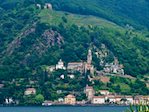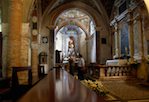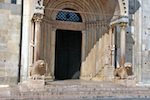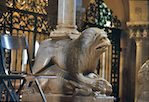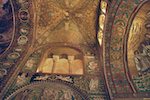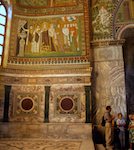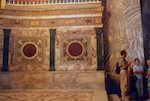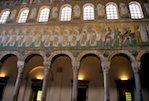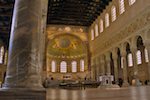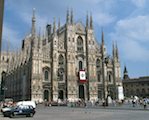Andrew and Babetta’s wedding was in the church of Santa Maria del Sasso, in Morcote, Switzerland. The church was probably built in the 13th Century, was completely rebuilt in 1462 in the Renaissance style and renovated in 1758 in the baroque style.
Below are a few pictures of after the wedding and of the reception (held in Porto Ceresio, Italy).
On our way south, we stopped at Modena trying to get some swag for Stacy’s then boss (Pierre Coulombe) from the Ferrari plant. The plant was closed, but the 12th Century Cathedral was wonderful.
We then went to Ravenna.
It was in this pre-Roman city that Julius Caesar gathered his forces before crossing the Rubicon (49 BC). In 402, Emperor Honorius transferred the capital of the Western Roman Empire from Milan to Ravenna. The transfer was made primarily for defensive purposes as Ravenna was surrounded by malaria swamps and had a port.
The Basilica of San Vitale was begun by Bishop Ecclesius in 527, when Ravenna was under the rule of the Ostrogoths, and completed by the 27th Bishop of Ravenna, Maximian in 548 during the Byzantine Exarchate of Ravenna.
The Mausoleum of Galla Placidia was built in 425-430 AD. The building contains three sarcophagi; the largest is said to have been that of Galla Placidia. The sarcophagus to the right is attributed to her son Emperor Valentinian III or to her brother, Emperor Honorius. The one on the left is attributed to Galla Placidia's husband, Emperor Constantius III.
The Basilica of Sant' Apollinare Nuovo was erected by the Arian King Theodoric as his palace chapel, during the first quarter of the 6th century. This Arian church was originally dedicated to Christ the Redeemer.
The Mausoleum of Theodoric (Italian: Mausoleo di Teodorico) was built in 520 by the Ostrogoth King Theodoric the Great as his tomb. Theodoric made Ravenna the capital of the Ostrogothic Kingdom of Italy.
After his battle against Mark Antony in 31 BC, Emperor Augustus founded Ravenna’s military harbor of Classe. This harbor, protected by its own walls, was an important station of the Roman Imperial Fleet. Today the city is landlocked, but Ravenna remained an important seaport on the Adriatic until the early Middle Ages.
The Basilica of Sant' Apollinare in Classe was consecrated on May 8, 549 by Bishop Maximian and dedicated to the first bishop of Ravenna and Classe.
The last stop on our trip was Milan.
The Cathedral is at least the third on this site and was built in the 15th century. Many consider it the climax of Gothic architecture in Italy.
